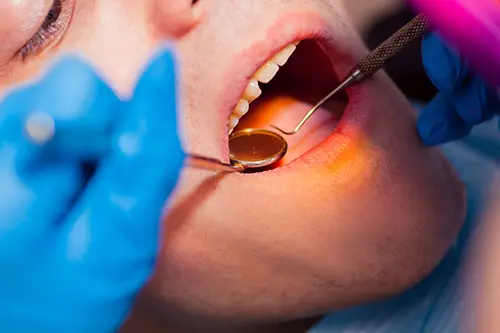Reviewed by Dr. Kerri Font, DDS

Reading time: three minutes.
Straightening your teeth can do wonders for your smile. But what if you have gum disease? Many patients ask us, “Can I still get braces if I have gum issues?” The short answer: not right away. If you have active gum disease, you need to treat it first.
This blog explains how gum health impacts orthodontic treatment, what your options are, and how our periodontists in Colorado can help you create a treatment plan that protects both your smile and your gums.
Table of Contents
- What Is Gum Disease?
- The Right Sequence: Periodontal Treatment Before Braces
- Schedule With a Periodontist First
Key Takeaway
You should not get braces with active gum disease. Braces and gum disease can lead to complete tooth loss and further bone loss if not managed properly. See a periodontist first to treat the infection, stabilize your gums, and create a safe, step-by-step plan for successful treatment with braces.
What Is Gum Disease?
Gum disease, also known as periodontal disease, is an infection of the soft tissue and bone that support your teeth. It develops gradually and can worsen over time if left untreated. There are several stages of gum disease, each with increasing severity:
- Gingivitis: The earliest stage, marked by red, swollen gums that may bleed when brushing or flossing. At this point, the damage is still reversible with good oral hygiene and professional cleanings.
- Early periodontitis: Plaque hardens into tartar, and inflammation begins to affect the supporting bone. Gums may start to recede, and pockets can form around the teeth.
- Moderate periodontitis: Infection spreads deeper below the gumline, leading to more significant bone loss and loosening of the teeth.
- Advanced periodontitis: The most severe stage, where the damage to bone and tissues can result in tooth loss and require surgical intervention.
Treating gum disease in its early stages is essential, especially before starting orthodontic treatment like braces.
Why Gum Disease Must Be Treated First
Braces apply constant pressure to move teeth into better alignment. But if your gum tissue and bone structures are already compromised, this movement can speed up tissue loss, bone damage, and tooth mobility.
Here’s what can happen if you get braces with active gum disease:
- Faster bone loss: Moving teeth in weakened bone accelerates deterioration.
- Increased gum inflammation: Brackets and wires make it harder to clean plaque.
- Higher risk of implant failure or tooth loss: Braces can cause weakened teeth to loosen further.
- Longer recovery time for both orthodontic and periodontal treatment: Healing may take longer if the gums are already compromised.
To preserve your natural teeth and ensure long-term oral health, our dental specialists recommend restoring periodontal health first. This includes maintaining excellent oral hygiene, attending regular dental checkups, and undergoing necessary professional cleaning.
The Right Sequence: Periodontal Treatment Before Braces
If you have gum disease, your first stop should be a periodontist. At our Highlands Ranch and Sloan’s Lake offices, we provide comprehensive care that sets you up for successful orthodontic care later.
Steps before getting braces:
- Comprehensive exam and digital imaging: To assess bone levels, gum health, and tooth stability.
- Scaling and root planing: Deep cleaning to remove plaque below the gumline.
- Ongoing maintenance cleanings: To prevent recurrence and stabilize gum tissue.
- Possible flap surgery or grafts: If bone or soft tissues need regeneration.
- Re-evaluation before braces: Once periodontal health is restored, we clear you for orthodontic care.
Only when your gums are infection-free and your bone tissue is stable can you move forward with braces or aligners.
Orthodontics After Gum Treatment: What to Expect
Even after gum disease treatment, you need a specialized plan when getting braces. We coordinate closely with your orthodontist to ensure that tooth movement happens safely.
What your treatment may include:
- Slower, controlled movement: To avoid stressing the jaw bones.
- Frequent periodontal checkups: To catch any early signs of recurrence.
- Customized hygiene plan: Including the use of an interdental brush to keep plaque under control.
- Options like Invisalign® or removable aligners: Easier to clean, lower risk of gum inflammation.
We tailor every treatment plan to the individual, because your bone health, soft tissue, and oral hygiene habits all matter.
Can You Get Braces If You Have a History of Gum Disease?
If your gum disease has been successfully treated and your gums are stable, you may be a candidate for braces or clear aligners. However, extra care is needed during orthodontic treatment to avoid a recurrence. This often means working closely with both your periodontist and orthodontist to monitor bone levels, inflammation, and overall gum stability throughout the process.
Orthodontic treatment in patients with a history of gum disease typically involves:
- A customized treatment plan with lighter forces to avoid stressing the bone.
- More frequent dental cleanings and periodontal checkups.
- Close monitoring of gum and bone health during tooth movement.
The key is making sure your mouth is healthy before any tooth movement begins. If you are unsure whether you are ready for braces, a periodontal evaluation is a smart first step.
Schedule With a Periodontist First
If you are considering braces and have a history of gum disease or signs of active gum problems, your first step should be a visit to a periodontist. At Highlands Ranch Periodontics & Dental Implants, we focus on building a healthy foundation before orthodontic treatment begins.
With offices in Highlands Ranch and Sloan’s Lake, we’re here to help you protect your smile for the long term.
Highlands Ranch Office
To book a periodontal consultation at our periodontal clinic in Highlands Ranch, CO, call (303) 683-1144 or visit us at 9090 S Ridgeline Blvd. #225, Highlands Ranch, CO 80129.
Sloan’s Lake Office
To book a periodontal consultation at our periodontal office in Sloan’s Lake, call (303) 683-1144 or visit us at 1525 North Raleigh Street Suite 130 Denver, CO 80204.
